The Samsung Galaxy Note5 and Galaxy S6 edge+ Review
by Joshua Ho on October 2, 2015 8:00 AM ESTDisplay
With the rise of smartphones and tablets, the display has become one of the most important aspects of a mobile device as it’s the primary mode of interaction. However, throughout computing the display has generally had relatively little attention. People might have talked about resolution, size, and latency, but the discourse was vague at best. In order to really understand displays, it’s important to discuss a number of factors that affect display quality and the underlying design of the display. These factors range from subpixel arrangement to TFT structure and various emitter materials. With traditional reviewing methods, it’s often difficult to say one way or another whether one display is “better” than another. While simple metrics like maximum brightness can be compared in a relative manner, it’s hard to say whether one has better colors or higher static contrast. In order to test these metrics, we turn to objective measurements from devices like X-Rite’s i1Pro2 spectrophotometer and i1Display Pro colorimeter. In order to acquire the data from these devices and present it in a usable manner, we use SpectraCal’s CalMAN 5 with a custom workflow.
Under the microscope and based upon some quick viewing angle tests, subjectively the Galaxy Note5 display looks and feels like a bigger version of the Galaxy S6 display. Viewing angles for some angles feels like the display is almost painted on to the glass below, but some odd interference effects with viewing angle changes breaks the illusion to some extent. In the case of the S6 edge+, the curved edges of the display cause a noticeable shift in luminance when looking at the edge compared to the center of the display, which also causes an odd green shift which is probably due to the RGBG subpixel layout. I suspect the best LCDs will still be better at the “painted to the glass” illusion for the near future. This isn’t a huge deal, but it is a noticeable difference.
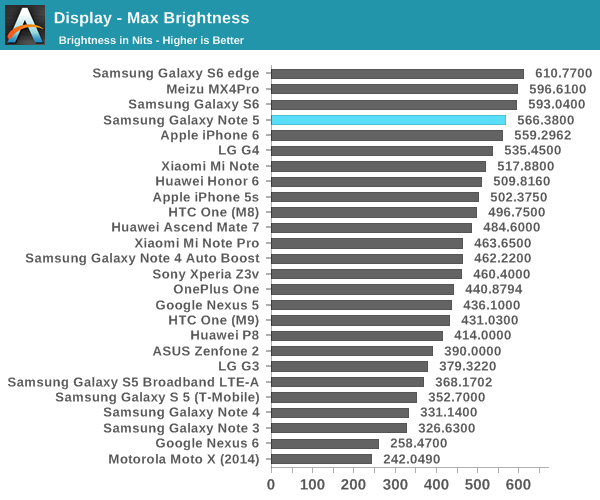
Moving on to our brightness testing, we can see that the Galaxy Note5 delivers a healthy improvement over the Galaxy Note 4 generation of AMOLED, but it isn’t quite at the same level as the Galaxy S6. It isn’t clear why this is the case, but I suspect this is related to longevity and other concerns outside of brightness. Meanwhile the use of OLED means that black levels are perfect and contrast remains solely determined by the lighting of the room and the reflectance of the display, which is similar to most other smartphones.
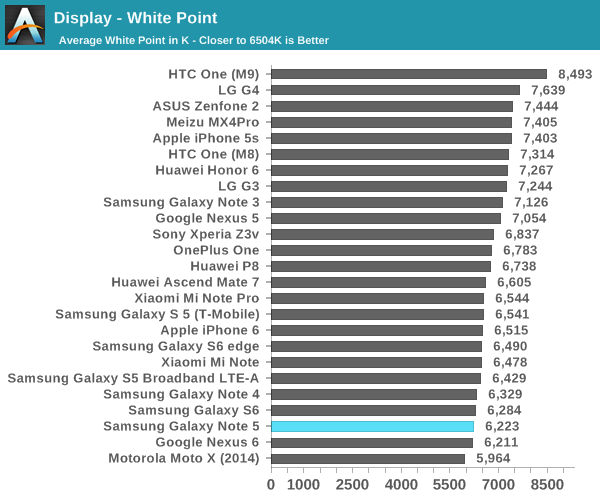
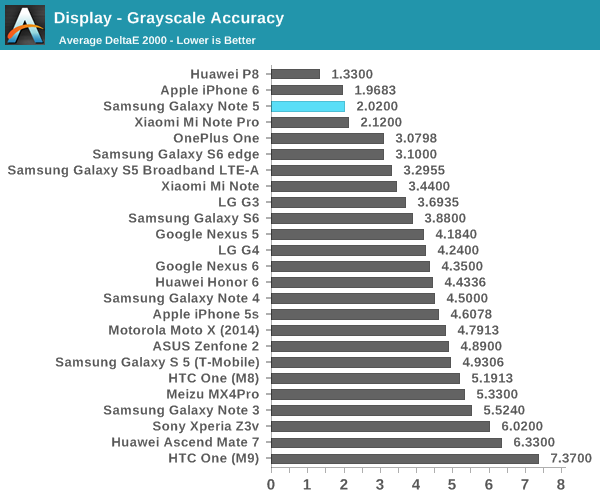
In our standard grayscale testing, the Note5 delivers acceptable color accuracy but it seems that the Basic screen mode tends towards a warm color balance. I suspect this helps with power efficiency, as blue in general requires more power to achieve the same level of luminance. Other than this slightly warm white balance, the grayscale accuracy doesn’t have any significant errors. This means accuracy ends up very good - certainly below our threshold for noticable errors - especially in comparison to the Galaxy Note 4 which had some noticeable problems with green tint on some units.
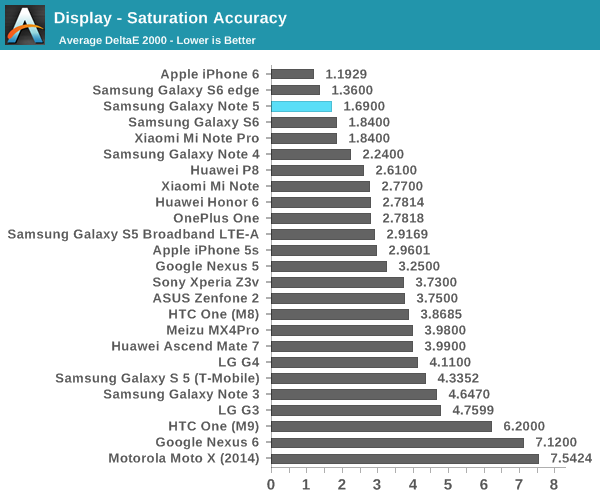
In our saturation test, Samsung does well enough that there’s really nothing to talk about because there's so little wrong here. You could argue that magenta is a bit warm on our review unit, but the difference is too small to be worth talking about. Error on average is going to be hard to spot unless you have a flawless reference monitor to compare against.
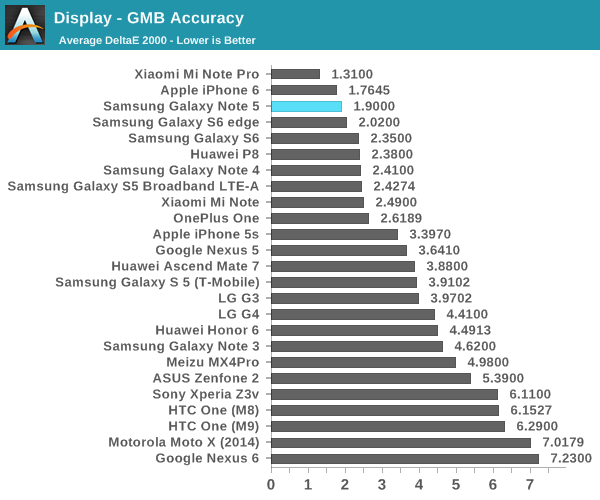
In the GMB ColorChecker test, Samsung continues to show a strong performance when looking at various hues that are commonly found in consumer content such as movies and camera photos. There’s a slight red shift on some of the tested hues, but the error is so minor I don’t notice that any problems here.
Overall, the Galaxy Note5 and Galaxy S6 edge+ both have an incredible display. The Galaxy S6 edge+ does have some problems with viewing angle shifts by virtue of the curved display, but this is effectively unavoidable given the subpixel layout and the radius of curvature. With this generation of AMOLED, Samsung has definitely equaled the best LCDs on the market. I suspect within the next year or two it will be inevitable that Samsung AMOLED will be clearly superior to even the best LCDs. However, without other OLED suppliers that can provide similar quality and cost I suspect OEM adoption will continue to be limited.



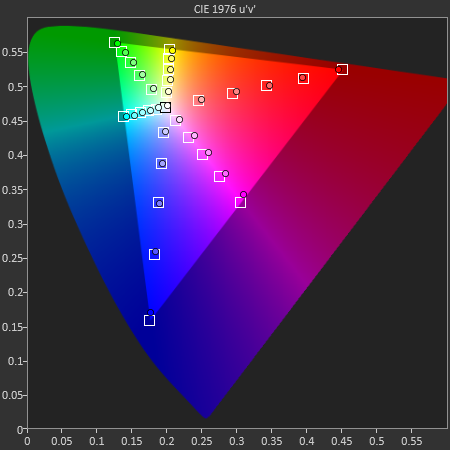
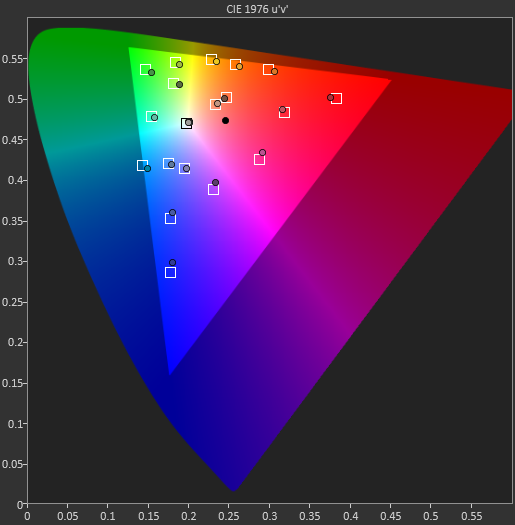








225 Comments
View All Comments
JoshHo - Friday, October 2, 2015 - link
This is with auto-boost. Given that the majority of people will only use auto-brightness the maximum brightness listed is achievable.Endgame124 - Friday, October 2, 2015 - link
Just read through the whole article. Did I miss a section regarding mobile data and call reception? Wifi performance is detailed, which is fine, but honestly, if I'm at home or somewhere where I know there is going to be wifi, I'll just bring my tablet.#1 most important feature on a smart phone? Reception. Its maddeningly difficult to get good comparisons across phones when it comes to reception for data and call quality / handlng.
JoshHo - Friday, October 2, 2015 - link
I agree that reception quality is important, but the issue here is that proper testing is an enormously difficult task. This is something that I want to resolve but I'm not sure how long it will take.Peichen - Monday, October 5, 2015 - link
Agreed about very difficult to test because the balls/bars on display doesn't really represent real dB.tipoo - Friday, October 2, 2015 - link
Sup with the Samsung NAND results getting nuked? In the GS6 review they were head and shoulders above the rest of the Android camp, now they're upper-middling. Different settings?Ryan Smith - Friday, October 2, 2015 - link
Different NAND.JoshHo - Friday, October 2, 2015 - link
To add on to this, the main difference is that we're only showing a single IO thread and QD=1 to avoid unnecessarily penalizing eMMC as we found that multiple IO threads is usually an unrealistic workload and that it would negatively affect eMMC performance.syxbit - Friday, October 2, 2015 - link
If the Note series are going to use the same SoC as the Galaxy S series, it would make sense to release them at the same time. Like Apple does.I was disappointed to see that the Nexus 6P uses the SD810. It's far worse than the competition. Since I like Android, and dislike Touchwiz, I have little choice. 2015 has been a bust for all SoC vendors except Samsung and Apple....
Kuzi - Saturday, October 3, 2015 - link
Syxbit, I own an Xperia Z4 Tablet that runs on SD810 v2.1, this newer version doesn't suffer from the overheating and excessive throttling issues first found on the HTC M9, and performance is around 10% higher.I compared it with my Galaxy S6 and found performance pretty similar, the Xperia is actually slightly faster in GFX Bench and 3Dmark graphics tests. The GS6 has slightly faster CPU and IO performance. But overall performance is great, and that is running 2560x1600 resolution.
My guess is that all newer devices released after June/July this year are running the improved SD810 V2.1. So Nexus 6P will surely run on this.
Ziich - Saturday, October 3, 2015 - link
I don't really know which doc you were expecting. i don't think the 820 is ready and i don't think samsung is selling their exynos soc to other oems